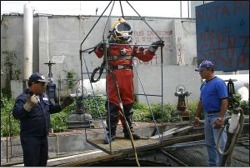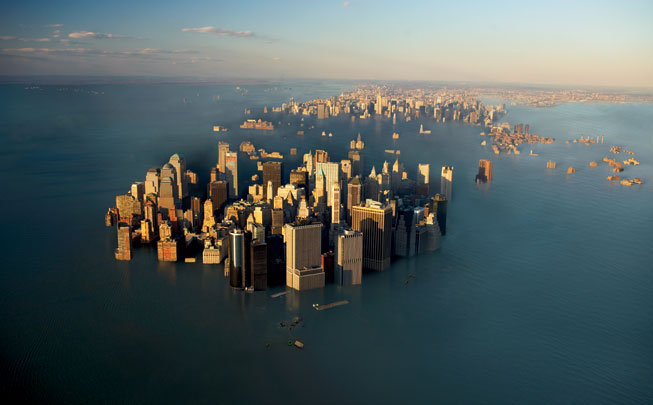
Energy, Food, and Sewage © Eric R. Pianka "What is the use of a house if you haven't got a tolerable planet to put it on?" -- Henry David Thoreau Energy "The future is green energy, sustainability, renewable energy -- Arnold Schwarzenegger" One of the many symptoms of the human overpopulation crisis is that we are facing serious energy limitations. People need to understand more about energy. Most people seem to think that we just need more, more, more. Our voracious and insatiable appetite for energy is doing us in. Americans are now suffering from painful increases in the cost of gasoline at the pumps with no end in sight. People are clamouring for alternative new sources of energy. Many, including our leaders, seem to think that we do not have to obey laws of thermodynamics. Using energy always produces heat, and unless it can be dissipated, temperatures must rise. Actually, we will have to learn to live more frugally using much less energy. Two distinct kinds of energy sources exist: renewable versus non-renewable sources. Solar and wind energy is renewable, but fossil fuels are finite and are quickly being used up. Although some fools delude themselves into thinking that oil replenishes itself deep in the Earth, it does not. Unfortunately, humans have become very dependent upon fossil fuels because they are portable, concentrated, and easily stored and transported. One gallon of gasoline will move a car weighing over a ton twenty or thirty miles. Other energy sources, such as sun and wind are not nearly as versatile. A wealthy Texan drives a Tesla all-electric car with the vanity license plate "NO CO2" -- little does he know that the electric energy, he plugs his slick car into, is generated by burning fossil fuel. As human populations burgeon and economies grow, demand for limited supplies has driven up the price of oil. An important facet is energy return on investment (EROI). In the 1930s, oil gushed out of wells under artesian pressure and EROI was around 100:1. By 1970, EROI had dropped to about 30:1, but today domestic oil must be pumped out from depths at considerable cost and EROI has fallen to about 10:1. A minimum EROI above the breakeven point of one is necessary for civilization to endure. Gasohol and tar sands are two examples of energy sources that fall below this minimal EROI threshold. More energy is actually required to produce a gallon of ethanol than is returned when it is burned! Prohibitively huge amounts of energy will be needed to extract fossil fuel from the now infamous Canadian tar sands. Some pseudo-scientists under the payroll of big oil assert that oil and natural gas supplies are adequate to get us through to the end of 2100, but no one knows how long dwindling supplies will last in the face of peak oil and rapidly increasing worldwide demand. Vast reserves of coal exist, but so-called "clean coal" is just another oxymoron. Burning coal produces large amounts of pollutants and greenhouse gases. The future impact of global warming is coming up on us very fast (Heinberg 2003, Oreskes and Conway 2014). Because people have electrical outlets all over their houses and offices, they suffer from the illusion that electricity is clean energy, infinite in supply and will always be there. None of these assumptions is true -- unless we convert to an electrical system based on renewable resources such as solar energy, power grids must ultimately fail and the internet will cease to be. Whenever you turn on a light or an air conditioner, chances are that coal or methane is being burned to generate the electricity you're using. A relatively small amount of electricity is generated by other sources such as by wind, hydro-electric, and/or solar energy. When you turn on a light, you are usually releasing solar energy captured by plants millions of years ago -- essentially, you are being illuminated by fossil sunlight that fell on the Earth long ago before humans even existed. Unfortunately, electricity is difficult to store and usually must be used immediately. Battery technology to improve our ability to store electric energy has been painfully slow. Grandfather clocks are powered by gravity. Pulling the weight up provides power that is generated over a much longer time period as it slowly falls. The great Dr. Jay Wright Forrester, a professor at MIT, grew up in rural Nebraska. While he was still in high school, Forrester rigged up a wind powered 12-volt DC electrical system using a windmill and an automobile generator. Essentially, the wind turned the generator. But, what to do when the wind didn't blow? Inspired by a grandfather clock, Forrester came up with a solution: when the wind DID blow, it lifted a heavy weight, then when it was calm, the weight fell by gravity turning the generator and switching polarity. Dr. Forrester invented "system dynamics" and won the Institute of Electrical and Electronics Engineers Medal of Honor in 1972. One of the big problems with wind power is its intermitancy. Electricity is difficult to store. Battery technology has been slow and is both inefficient and limited. We could exploit grandfather clock technology on a massive scale to store excess energy during times of plenty for use later when electricity is needed, as follows: Energy could be stored by laying rails going down on a hillside -- when excess energy is available, use it to pull up something heavy like an old locomotive. When the wind stops blowing it would turn over a DC generator as it fell back down. These giant "gravity batteries" wouldn't even have to be close to the wind turbines but could be many miles away. This same mechanism has been used to pump water uphill during periods of excess wind energy, which is then reclaimed later as hydroelectric power. We need to convince people, especially politicians, of the importance of being proactive and using the last of our diminishing oil reserves to invest in infrastructure, especially electricity grids and railways. We should also develop and install green technologies, such as solar water heating systems as well as photovoltaic and wind turbine driven electrical generating plants. Converting to a solar-powered electrical energy system would greatly reduce carbon emissions from the burning of non-renewable fossil fuels. Switching over to renewable sources of energy (wind and sun) would also make our electrical grid system more stable and reliable in the future. However, switching over to renewable energy is not nearly as simple and easy as many people might hope (Oreskes 2014, Foss, 2012): if all humans stopped burning fossil fuels entirely right now, the planet will continue to warm for some decades. Earth simply cannot support all 7+ billion of us, certainly not in the energy-consuming life style in which we'd all like to live. Politicians are quick to promise energy solutions, but always by the year 2020 or 2050, too far into the future to alleviate pressing present problems. Moreover, they adamantly ignore the underlying causal problem: too many people. To keep spirits up, politicians and corporations invent and exploit expressions like "sustainable growth," "sustainable development," and "clean energy." People do not analyze these expressions, but prefer blissful ignorance vis-a-vis their meaning. However, stringing such antonyms together merely creates irresponsible oxymorons. Most people remain in a state of massive denial, impervious and oblivious to the impending crisis. Of course, humans are clever, so clever that we have actually figured out how to turn matter into energy by exploiting fission and fusion. Many people think that an unlimited supply of energy is therefore available. Nuclear energy may be virtually limitless, but it carries serious environmental hazards (particularly thermal pollution and radioactive waste). A few engineers see infinite energy prospects in beaming more solar energy from outer space to the planet's surface. A Japanese company is actually proposing to capture solar energy on the moon and transmit it to Earth. People just don't get it! Access to unlimited energy would lead to our downfall. Such energy would enable well-meaning but uninformed massive energy consumption and habitat destruction. Mountains would be levelled and terraced, massive water canals would be dug, ocean water distilled, water would be pumped and deserts turned into green fields of crops. Human populations would grow even higher until the last vestiges of natural habitats are all destroyed. Heat dissipation would of course set limits, for when more heat is produced than can be dissipated, the resulting thermal pollution would quickly warm the planet to the point that all life is threatened, perhaps the ultimate ecocatastrophe. In fact, this scenario is already happening even as many people remain locked in denial, steadfastly refusing to admit that a crisis even exists (Oreskes et al. 2014). (Die-hard technologists will no doubt argue that we will invent ways to shoot our excess waste heat out into space.) Bottom line: Burning fossil fuels of any sort, and using energy in any way even via nuclear reactors only adds insult to injury because such activities produce waste heat that cannot be dissipated. Hence we are actually speeding up the rate of global warming by all our efforts to find and use more energy, fracking included. Our steadfast refusal to live by the rules of thermodynamics is rapidly shortening the time left for all life on planet Earth, our one and only spaceship. "The belly is an ungrateful wretch, it never remembers past favors, it always wants more tomorrow." ― Aleksandr Solzhenitsyn "Oh, belly. Thou bag of stinking breath, foul at either end" Famines have occurred throughout human history and hunger is widespread today even in developed countries. Humans are eating more than can be replenished and world food reserves are falling. During times of plenty, surplus food can be stored, exported, or fed to animals. Food storage prospects are often limited by storage facilities, insect pests, rodents, and time. Wise leaders recognize that crop failures are inevitable and try to establish food reserves that allow a margin of safety. Global food reserves are currently at their lowest levels in 40 years and food prices are rising rapidly. Crop failures due to droughts caused by climate change have put greater pressure on food supplies. Widespread food shortages are imminent. Food has become a mere commodity to be bought and sold capriciously, without consideration from whence it came. Most people have lost touch with nature, which was once the source of their succor. Many seem to have forgotten where food comes from -- some people may think that boxes of Triscuits  grow on supermarket shelves (essentially, they sort of do, because when a box is scanned during its
sale, a computer automatically places an order for a new box which arrives on the next truck).
Crop failures would seem to be inevitable.
grow on supermarket shelves (essentially, they sort of do, because when a box is scanned during its
sale, a computer automatically places an order for a new box which arrives on the next truck).
Crop failures would seem to be inevitable.
Food Supplies Agriculture: Our Worst Mistake Wikipedia: Anarcho-primitivism LA Times: Hunger Old Forecast of Famine May Yet Come True creeks and rivers. Eventually, however, freshwater drainage systems became overloaded. Now, most freshwater ecosystems are heavily polluted. As a result, amphibians and many freshwater fish are threatened or endangered worldwide.  With the advent of agriculture, human populations surged and we began to live in towns
and cities. The problem of disposing of human wastes intensified. By 2700 B.C., some
ancient cities had leakproof plumbing pipe systems. Septic systems were invented. In
some eastern societies such as China and Japan, people collected human waste in "honey pots"
to be recycled as fertilizer.
With the advent of agriculture, human populations surged and we began to live in towns
and cities. The problem of disposing of human wastes intensified. By 2700 B.C., some
ancient cities had leakproof plumbing pipe systems. Septic systems were invented. In
some eastern societies such as China and Japan, people collected human waste in "honey pots"
to be recycled as fertilizer.
Many of the world's major cities are conveniently located along seacoasts, allowing for easy disposal of sewage into the oceans. While it used to be raw sewage, now it's usually variously treated. How can a big city like Los Angeles actually exist? One day's human wastes from LA would fill many Olympic-sized swimming pools. Like all coastal cities, LA originally dumped its sewage into the sea, forming a great undersea alluvial fan that stretches out for miles and is thousands of feet deep. When these massive wastes built up too much, bacteria became a threat to human health, and LA switched to disposing of its treated sewage at a terrestrial facility in Kern County called "Green Acres." When this became too controversial, the authorities switched the disposal area to Kings County. Some cities dump their wastes into large lakes which undergo eutrophication as nutrient levels, especially phosphorus, build up. During this process, a lake changes from being a clear blue oligotrophic lake (nice for boating) to a cloudy, often smelly, brown eutrophic one -- its phytoplankton change as blue green algae take over. This leads to changes in the zooplankton and fish inhabiting the lake. An oligotrophic lake supports desirable fish like trout, whereas only trash fish such as carp can live in a eutrophic lake. The city of Seattle originally dumped its sewage into Lake Washington until that lake became overly enriched causing algal blooms and toxic conditions that led to fish die offs. At its peak, 20 million gallons of treated effluent was dumped into the lake each day. Lake Washington was called "El Stinko." Conveniently, an even larger body of seawater Puget Sound was nearby. From 1963-1968, a massive tunnel was constructed that diverted Seattle's sewage effluent into the ocean. Lake Washington recovered and became a clear oligotrophic lake again, its phytoplankton, zooplankton, and fish returned to their original composition. Most other lakes in the world cannot be restored.  Every year, trillions of gallons of raw sewage are dumped into the world's creeks, rivers,
lakes, and oceans. Sewage plants are strained to capacity and populations are still expanding.
Human wastes are building up.
Every year, trillions of gallons of raw sewage are dumped into the world's creeks, rivers,
lakes, and oceans. Sewage plants are strained to capacity and populations are still expanding.
Human wastes are building up.
How can a huge inland city like Mexico City exist without an ocean to receive its wastes? Reportedly, its 20 million people flush 10,000 gallons a second, enough to fill an Olympic-sized pool every minute! Mexico City has 600 miles of sewer tunnels,  some measuring 20 feet wide dating back
to the ancient Aztecs. These tunnels sometimes get clogged -- then brave sewage divers must descend
into them to clear blockages. On occasion, dead bodies have been discovered deep in the
bowels of Mexico City. some measuring 20 feet wide dating back
to the ancient Aztecs. These tunnels sometimes get clogged -- then brave sewage divers must descend
into them to clear blockages. On occasion, dead bodies have been discovered deep in the
bowels of Mexico City.
In some parts of the world, especially in poor countries in Africa and Asia, sanitation is inadequate. Water-borne diseases like cholera can easily become epidemics under such situations. Imagine the sheer volume of the billions of turds produced by all the world's humans each and every day. Sure, many people are starving and won't produce much, many others are mere babies in diapers, but still, that's an awful lot of human faecal matter and it tends to build up over the course of years and decades. "I just think cities are unnatural, basically. I know there are people who live happily in them, and I have cities that I love, too. But it's a disaster that we have moved so far from nature" -- Alice Walker Urbanization has been a steady process for thousands of years (Mumford 1961): in many countries 75% or more of the people now dwell in cities (Watson 1993). Without agriculture and fossil fuels, we could never have built cities, let alone developed our civilization and human knowledge. Cites foster development of trade and the accumulation of wealth. Universities cannot exist without cities. Cities attract people because they offer jobs and most grow. In fact, suburbs of some large cities have grown relentlessly, creating mega cities like Dallas-Fort Worth and Minneapolis-Saint Paul. More than half the world's populace were living in cities in 2007 (Nations 2007). People love cities, many of which have familiar nicknames like the big apple, the windy city, big easy, and sin city. Many have slogans like "Keep Austin Weird" or "What Happens Here, Stays here". Cities are a mixed blessing, however, because they also lead to serious social and economic challenges, and foster overcrowding, poor sanitation, disease, drug use, crime, slums and poverty (Watson 1993, Nations 2007, Wells 2010). People are often unaware of the enormous footprint required to sustain a large city. Without a steady inflow of massive amounts of food, water, and power and a continual outflow of garbage and sewage, cities will collapse. 
New York City goes under as sea levels rise Most of the world's great cities are on coastal areas and therefore subject to flooding during hurricanes and rising sea levels. Cities rely on massive transportation, which requires a lot of energy. In many ways, cities are little more than giant but fragile feed lots supporting unsustainably dense aggregations of people. As sea levels and energy costs rise and supplies of food and water fall, cities become more and more precarious. Last updated 15 September 2014 by Eric R. Pianka |